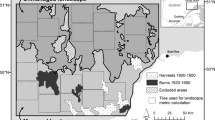Abstract
As a contribution to the BOReal Ecosystem Atmosphere Study (BOREAS), a total of 97 sites have been surveyed in the boreal forest regions of Manitoba and Saskatchewan. The sites extend across an ecoclimatic transect through the boreal forest of central Canada, from aspen parkland to sub-arctic woodland. Sites were selected using satellite, air photograph, and forest cover map data. Each site represents a minimum 100 m by 100 m homogeneous stand, suitable for satellite imaging. Data collected at each site covers overstory (species composition, DBH, pathogens, age, etc.), understory (percent cover by species), debris, and soil characteristics. These data provide a background database for the diverse measurements of terrestrial ecology, land surface climatology, tropospheric chemistry, and remote sensing. Such data provide an important baseline for ongoing studies of the boreal forest in a region sensitive to global change. The results of this study aid integration of a variety of more detailed studies being carried out in the region and also allow comparison with other international studies of a similar nature. Sites are concentrated in two regions: north of Prince Albert, Saskatchewan, and west of Thompson, Manitoba. Additional sites are located in the area of the Boreal Forest Transect Case Study (BFTCS) between Batoche, Saskatchewan and Gillam, Manitoba. The surveyed sites were classified according to three criteria: dominant species (Picea mariana, Populus tremuloides, Pinus banksiana, or “mixed”), age (mature, immature, or young/recently disturbed), and productivity (low, medium, or high). Overstory and understory measurements were usually taken at three points within each site. Debris measurements were taken at two points, and soil measurements at one point per site. This paper focuses on overstory and debris data taken at 97 sites in 1993 and 1994. The sites are predominantly in medium and high productivity stands. Overstoiy. data, primarily from point-sampling, have been used to estimate stand basal areas, stem densities, volumes, and aboveground biomass (excluding foliage). Stand basal areas ranged from 5 m2 ha−1 to over 60 m2 ha−1. Stem densities ranged from a few hundred to over 40 000 stem ha−1. Estimates of total aboveground biomass range from a few Mg ha−1 to over 250 Mg ha−1. The Prince Albert sites tend to have greater values than Thompson for basal area, volume and biomass, but stem densities are highly variable. Detritus data show values from zero to 60 Mg ha−1. Generally, these values are small compared to aboveground biomass, but in recently disturbed sites the detrital mass can exceed aboveground biomass.
Similar content being viewed by others
References
Alexeyev, V. A., Korotkov, I. A., Stakanov, V. D. and Birdsey, R. A.: 1995, Water,Air, Soil Pollut. 82, 271–282.
Apps, M. J., Albu, P., Halliwell, D., Niederleitner, J., Seburn, D. and Siltanen, M.: 1994a, BOREAS biometry and auxiliary sites: overstory and understory data, (Version 1.0). Can. For. Serv. Rep., Northwest Region, Edmonton, Canada, 124 pp.
Apps, M. J., Niederleitner, J., Seburn, D., Varem-Sanders, T. and Siltanen, M.: 1994b, BOREAS biometry and auxiliary sites: locations and descriptions, (Version 1.0). Can. For. Serv. Rep., Northwest Region, Edmonton, Canada, 33 pp.
Apps, M. J., Albu, P., Halliwell, D., Price, D. T., Siltanen, M. and Varem-Sanders, T.: 1995, BOREAS biometry and auxiliary sites: soils and detritus data, (Version 1.0). Can. For. Serv. Rep. Northwest Region, Edmonton, Canada, 73 pp.
Apps, M. J., Goodison, B., Cihlar, J. C., Hall, F., Leckie, D., LeDrew, E., Matson, P., Running, S. and Sellers, P. J.: 1991,BOREAS: Global Change and Biosphere-Atmosphere Interactions in the Boreal Forest Biome, Science Plan, NASA, Goddard Space Flight Center, Greenbelt, USA, September 1991, 67 pp.
Avery, T. E. and Burkhart, H. E.: 1983,Forest Measurements, 3rd edn., McGraw-Hill, New York, USA, 331 pp.
Bonnor, G. M.: 1985,Inventory of Forest Biomass in Canada, Can. For. Serv. Petawawa National Forestry Institute, Chalk River, Canada, 63 pp.
BOREAS Science Steering Committee: 1990,Eos 72, 33–40.
Canada Soil Survey Committee: 1978,The Canadian System of Soil Classification, Agric. Can. Publ.1646, Ottawa, Canada, 164 pp.
Hogg, E. H. and Hurdle, P. A.: 1995,Water, Air, Soil Pollut. 82, 391–403.
Huang, S., Titus, S. J. and Wiens, D. P.: 1992,Can. J. For. Res. 22, 1297–1304.
Husch, B., Miller, C. I. and Beers, T. W.: 1982,Forest Mensuration, 3rd edn., Wiley, New York, USA, 402 pp.
Isaev, A., Korovin, G., Zamolodchikov, D., Utkin, A. and Pryaznikov, A.: 1995,Water, Air, Soil Pollut. 82, 247–256.
Krankina, O. N. and Harmon, M. E.: 1995,Water, Air, Soil Pollut. 82, 227–238.
Land Resource Research Institute: 1983, Hay J. H. (ed.).The Canadian Soil Information System (CanSIS): Manual for Describing Soils in the Field. LRRI Contrib. No 82-52, Agric. Can., Ottawa, Canada, 164 pp.
McRae, D. J. Alexander, M. E. and Stocks B. J.: 1979,Measurement and Description of Fuels and Fire Behavior on Prescribed Burns: A Handbook, Can. For. Serv. Inf. Rep. O-X-287, Great Lakes Region, Sault Ste. Marie, Canada, 58 pp.
Price, D. T. and Apps, M. J.: 1995,Water, Air, Soil Pollut. 82, 203–214.
Prince, S. D., Goetz, S. J. and Goward, S. N.: 1995,Water, Air, Soil Pollut. 82, 509–522.
Singh, T.: 1982,Biomass Equations for Ten Major Tree Species of the Prairie Provinces, Can. For. Serv. Inf. Rep.NOR-X-242, Northern Forest Research Centre, Environment Canada, Edmonton, Canada, 35 pp.
Van Wagner, C. E.: 1982,Practical Aspects of the Line Intersect Method, Can. For. Serv. Inf. Rep.PI-X-12, Petawawa National Forestry Institute, Chalk River, Canada, 11 pp.
Author information
Authors and Affiliations
Rights and permissions
About this article
Cite this article
Halliwell, D.H., Apps, M.J. & Price, D.T. A survey of the forest site characteristics in a transect through the central Canadian boreal forest. Water Air Soil Pollut 82, 257–270 (1995). https://doi.org/10.1007/BF01182839
Issue Date:
DOI: https://doi.org/10.1007/BF01182839




